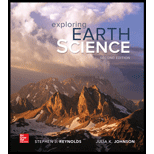
The features of types of air mass, its location of formation, and the process by which it influences the climate of the region.
Answer to Problem 1BYL
The two types of air masses are Continental Air Masses and Maritime Air Masses. The Continental Air Mass is categorized into Continental tropical air mass, Arctic or Antarctic air mass, and Continental Polar air mass. The Maritime Air Masses is categorized into Equatorial air mass, Maritime tropical air mass, and Maritime polar air mass.
Explanation of Solution
There are majorly two types of air masses-Continental Air Masses and Maritime Air Masses.
The types of Continental Air Masses are explained as follows:
(i) Continental tropical (cT) air mass:
It is a hot, dry air mass that occurs over land. It occurs in the Desert Southwest of North America, the Sahara, and Arabian Deserts, Tibet, and central Australia. It makes the climate of a region oppressively hot and dry.
(ii) Arctic or Antarctic (A) air mass:
These air masses are extremely cold and at the same time very dry because they contain low capacity of water-vapors. These air masses occur near the North and South Poles. It brings very cold air into the concerned region.
(iii) Continental polar (cP) air mass:
These air masses are cold and dry, but comparatively less cold and dry than Arctic or Antarctic air mass. They form over cold, inland areas of northern Canada, Siberia, Mongolia, and north-central Europe. These air masses bring cold air in winters, but in summers; the air masses are not as cold.
The types of Maritime Air Masses are described as follows:
(i) Equatorial (E) air mass:
These air masses are very warm and moist, which form near the equator. These air masses bring warm and moisture-laden air into the concerned region.
(ii) Maritime tropical (mT) air mass:
These air masses are warm and moist. They form over warm, oceanic regions of the Atlantic Ocean and adjacent eastern U.S. They make the affected region warm and humid in summer.
(iii) Maritime polar (mP) air mass:
These air masses are cool and humid, but not as cold as cP air mass. They form over Seattle and most of Western Europe. These air masses bring cold, damp air into the concerned region.
Want to see more full solutions like this?
Chapter 16 Solutions
Exploring Earth Science
 Applications and Investigations in Earth Science ...Earth ScienceISBN:9780134746241Author:Edward J. Tarbuck, Frederick K. Lutgens, Dennis G. TasaPublisher:PEARSON
Applications and Investigations in Earth Science ...Earth ScienceISBN:9780134746241Author:Edward J. Tarbuck, Frederick K. Lutgens, Dennis G. TasaPublisher:PEARSON Exercises for Weather & Climate (9th Edition)Earth ScienceISBN:9780134041360Author:Greg CarbonePublisher:PEARSON
Exercises for Weather & Climate (9th Edition)Earth ScienceISBN:9780134041360Author:Greg CarbonePublisher:PEARSON Environmental ScienceEarth ScienceISBN:9781260153125Author:William P Cunningham Prof., Mary Ann Cunningham ProfessorPublisher:McGraw-Hill Education
Environmental ScienceEarth ScienceISBN:9781260153125Author:William P Cunningham Prof., Mary Ann Cunningham ProfessorPublisher:McGraw-Hill Education Earth Science (15th Edition)Earth ScienceISBN:9780134543536Author:Edward J. Tarbuck, Frederick K. Lutgens, Dennis G. TasaPublisher:PEARSON
Earth Science (15th Edition)Earth ScienceISBN:9780134543536Author:Edward J. Tarbuck, Frederick K. Lutgens, Dennis G. TasaPublisher:PEARSON Environmental Science (MindTap Course List)Earth ScienceISBN:9781337569613Author:G. Tyler Miller, Scott SpoolmanPublisher:Cengage Learning
Environmental Science (MindTap Course List)Earth ScienceISBN:9781337569613Author:G. Tyler Miller, Scott SpoolmanPublisher:Cengage Learning Physical GeologyEarth ScienceISBN:9781259916823Author:Plummer, Charles C., CARLSON, Diane H., Hammersley, LisaPublisher:Mcgraw-hill Education,
Physical GeologyEarth ScienceISBN:9781259916823Author:Plummer, Charles C., CARLSON, Diane H., Hammersley, LisaPublisher:Mcgraw-hill Education,





